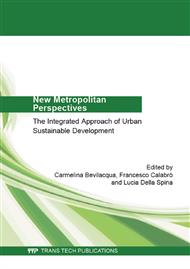[1]
Transit Cooperative Research Program. Transit-Oriented Development and Joint Development in the United States: A Literature Review. Research Results Digest. Transportation Research Board, Washington, DC, (2002).
DOI: 10.17226/14588
Google Scholar
[2]
H. Dittmar, G. Ohland, The New Transit Town: Best Practices in Transit – Oriented Development. Island Press (2004).
Google Scholar
[3]
M. Pacione, Urban Geography: a Global Perspective. London. Routledge. (2009).
Google Scholar
[4]
P. Calthorpe, The Next American Metropolis: Ecology, Community, and the American Dream. Princeton Architectural Press, New York (1993) pg 43.
Google Scholar
[5]
T. Still , Transit-Oriented Development: Reshaping America's Metropolitan Landscape. On Common Ground, Winter (2002) pp.44-47.
Google Scholar
[6]
National Research Council, TCRP Report 102: Transit-Oriented Development in the United States: Experiences, Challenges, and Prospects. Washington, DC: The National Academies Press, (2004).
DOI: 10.17226/23360
Google Scholar
[7]
Transit Cooperative Research Program (TCRP), An Evaluation of the Relationships Between Transit and Urban Form, Research Results Digest, No. 7, Transportation Research Board, Washington, DC. (1995).
DOI: 10.17226/24981
Google Scholar
[8]
A. Tallon, Urban Regeneration in UK. Routledege. (2012).
Google Scholar
[9]
H. Zeng, One the move: Urban Design for access. The city fix http: /thecityfix. com/blog/on-the-move-urban-design-for-access-heshuang-zeng/, (2014).
Google Scholar
[10]
R. Cervero , S. Murphy, C. Ferrell, N. Goguts, Y. Tsai, G. B. Arrington, et al. Transit-oriented development in the United States: Experiences, challenges, and prospects (TCRP 102). Washington, DC: Transportation Research Board. (2004).
Google Scholar
[11]
S. Mathur, Innovation in Public Transport Finance: Property Value Capture by 2014, Ashgate. (2014) In press.
Google Scholar
[12]
K. Bartholomew and R. Ewing, Hedonic Price Effects of Pedestrian- and Transit-Oriented Development. Journal of Planning Literature (2011) 26(1): 18-34.
DOI: 10.1177/0885412210386540
Google Scholar
[13]
TOD 201, Mixed-Income Housing Near Transit Increasing Affordability With Location Efficiency. Reconnecting America (2009).
Google Scholar
[14]
S. Pollack, B. Bluestone, C. Billingham, Maintaining Diversity in America's transit-rich neghborhoods: tools for equitable neighborhood change. Dukakis Center publications. (2010).
Google Scholar
[15]
L. Freeman , Displacement or succession? Residential mobility in gentrifying neighborhoods, Urban Affair Review. (2005).
DOI: 10.1177/1078087404273341
Google Scholar
[16]
, 17] Kahn, Gentrification Trends in New Transit-Oriented Communities: Evidence from 14 Cities That Expanded and Built Rail Transit Systems. (2007).
DOI: 10.1111/j.1540-6229.2007.00186.x
Google Scholar
[18]
S. Pollack , B. Bluestone, C. Billingham, Maintaining Diversity in America's transit-rich neighborhoods: tools for equitable neighborhood change. Dukakis Center publications. (2010).
Google Scholar
[19]
K. Wardrip, Public Transit's Impact on Housing Costs: A Review of the Literature. Insight from Housing Policy Research. Center for Housing Policy, (2011).
Google Scholar
[20]
, 21] Reconnecting America, Mixed Income Housing near Transit, www. reconnectingamerica. org/assets/Uploads/091030ra201mixedhousefinal. pdf (2009).
Google Scholar
[22]
S. Cameron, Gentrification, housing redifferentiation and urban regeneration: going for growth, in Newcastle upon Tyne. Urban Studies, (2003) 40. 12, 2367–82.
DOI: 10.1080/0042098032000136110
Google Scholar
[23]
W. J. Wilson, The truly disadvantaged: the inner city, the underclass, and public policy. University of Chicago Press, Chicago, (1987).
DOI: 10.1177/088610998800300312
Google Scholar
[24]
J. Logan, H. Molotch: Urban fortunes: the political economy of place. University of California Press, Berkeley, CA (1987).
Google Scholar
[25]
H. Lefebvre: The right to the city (1968).
Google Scholar
[26]
J. Duke: Mixed income housing policy and public housing residents' right to the city,. Critical Social Policy, (2009), 29. 1, p.100–20.
DOI: 10.1177/0261018308098396
Google Scholar
[27]
C. Bevilacqua, F. Cappellano, L. Zingali: TOD - Transit Oriented Development: a sustainable tool towards smart living, Proceedings of the 7th Conference of International Forum on Urbanism, (2013), pp.275-284.
Google Scholar
[28]
Reconnecting America: Transit-Oriented for All: The Case for Mixed-Income Transit-Oriented Communities in the Bay Area (2007).
Google Scholar
[29]
Arnstein, R. Sherry, A Ladder of Citizen Participation, JAIP, Vol. 35, No. 4, July (1969), pp.216-224.
Google Scholar
[30]
D. Harvey, The right to the city. New Left Review 53, (2008), September/October, p.23–40.
Google Scholar


